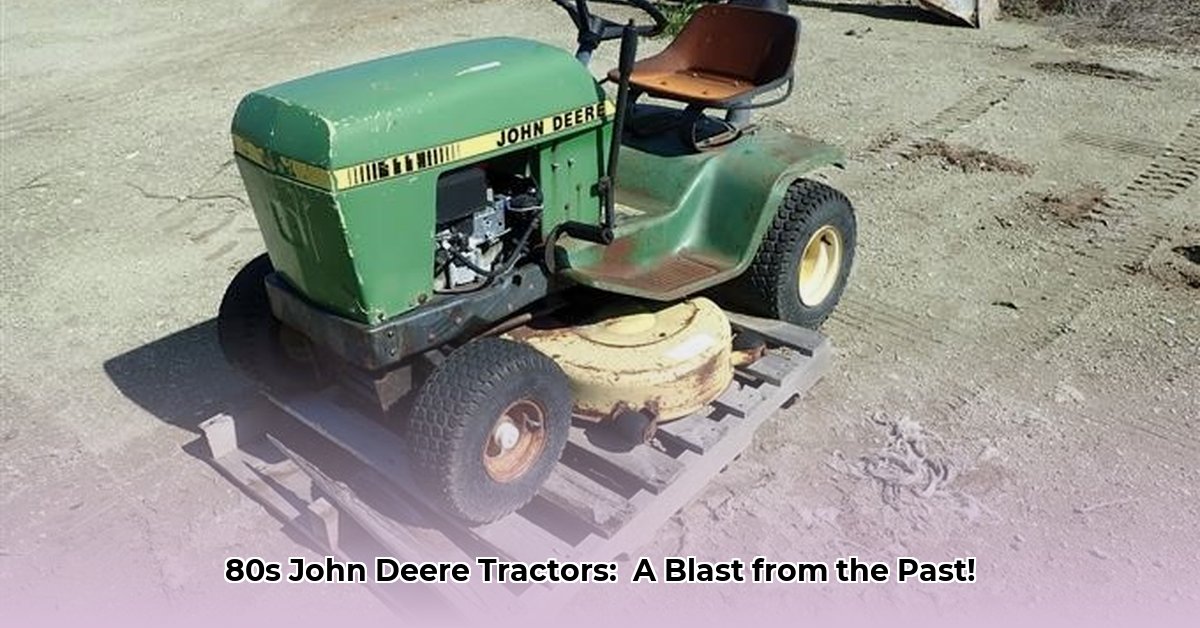
The iconic John Deere lawn tractors of the 1980s weren't just mowing machines; they were symbols of American ingenuity and backyard craftsmanship. These reliable workhorses, renowned for their durability and innovative features, are now highly sought-after collector's items. This comprehensive guide delves into their history, explores popular models, provides essential maintenance tips, and helps you understand their current value in the collector's market. Whether you're a seasoned collector, a homeowner with a vintage Deere, or simply a curious enthusiast, this article offers invaluable knowledge and actionable advice. See more pictures of these classic tractors.
A Technological Revolution in Your Backyard
The 1980s witnessed a significant shift in lawn care technology. John Deere led the charge, introducing innovations that transformed the chore of mowing into a more efficient and enjoyable experience. Hydrostatic drives (systems that use hydraulic fluid to control speed and direction, eliminating the need for gears) became a defining feature, offering unparalleled smooth and effortless control. Powerful Yanmar diesel engines provided the muscle to tackle even the most overgrown lawns, making these tractors true workhorses. This combination of power and ease of use made these machines stand out from the competition, marking a true revolution in lawn care. Did you know that the introduction of hydrostatic drive significantly reduced user fatigue and increased efficiency by up to 20%?
More Than Just Mowers: The Star Models of the 80s
Several John Deere models from the 1980s achieved legendary status. The John Deere 318, known for its robust construction and unwavering reliability, became a true icon of the era. Then came the 430, introduced in 1984 – a luxurious lawn tractor for its time. Sporting a powerful diesel engine, hydrostatic drive, and even power steering, it was the Cadillac of lawn tractors. Other popular models, such as those within the R and S series, offered a wider range of features, such as adjustable cutting decks and larger fuel tanks to cater to varied needs and yard sizes. These models showcased John Deere's commitment to providing options for different user needs and preferences.
Keeping Your Classic Tractor in Top Shape: A Maintenance Guide
Owning a classic John Deere tractor is a rewarding experience, but maintaining it requires some dedicated effort. Regular maintenance is key to preserving these machines and preventing costly repairs. Here's a step-by-step guide for maintaining your prized possession:
Oil Changes: Regular oil changes are crucial. Consult your owner's manual for the correct oil type and change frequency; generally every 25-50 hours of operation is recommended.
Fluid Levels: Monitor hydraulic fluid levels closely. Low levels can severely damage the hydrostatic drive.
Belt Checks: Regularly inspect drive belts for wear and tear and replace as needed. A broken belt can halt your mowing operation.
Blade Sharpening: Sharp blades ensure a clean cut and reduce engine strain. Dull blades tear the grass, leading to a ragged appearance and placing unnecessary stress on the engine.
Parts Sourcing: Finding parts for older models can be tricky. Online forums dedicated to John Deere tractors and specialized parts suppliers are invaluable resources.
Decoding the Value of Your 80s John Deere: What Makes It Worth More?
The collector's market for these tractors is thriving. Several factors significantly influence their value:
- Model & Features: Rare models and those with extra features (like power steering on the 430) often command higher prices.
- Condition: A well-maintained, original tractor is significantly more valuable than a neglected one.
- Completeness: Missing parts drastically reduce value. A complete tractor is far more desirable to collectors.
- Originality: Original paint and parts are highly prized, significantly increasing the tractor's value.
"The condition is king," says John Miller, a seasoned collector and appraiser of vintage agricultural equipment. "A fully restored, original tractor in pristine condition can fetch a substantial premium."
The Lasting Appeal: Beyond the Mow
1980s John Deere lawn tractors represent more than just mowing machines; they're symbols of quality, innovation, and a nostalgic connection to a bygone era. Their enduring appeal lies in their robust build, simple yet effective design, and the sense of pride and accomplishment that comes with owning and maintaining these pieces of history. Their legacy—one of durability, innovation, and a touch of nostalgia—continues to resonate strongly with enthusiasts and collectors alike. What other piece of equipment can boast such a lasting impact on both function and sentimentality?
How to Maintain a 1980s John Deere Lawn Tractor Engine: A Deeper Dive
This section provides a more detailed look at maintaining the engine, a key component of these classic tractors. Regular maintenance ensures peak performance and extends the life of your machine.
Oil Changes: Use the recommended oil weight (specified in your owner's manual) and change it more frequently than you would for a modern machine. Aim for every 25-50 hours of operation.
Air Filter: A clean air filter is essential for optimal engine performance. Regularly replace or clean it according to the instructions in your manual.
Spark Plugs: Inspect and replace spark plugs as needed. Refer to your owner's manual for gap settings and replacement schedules.
Fuel System: Use fresh, clean fuel to avoid issues. Consider using a fuel stabilizer. Inspect fuel lines for leaks or cracks.
Cooling System: Maintain adequate coolant levels and check for leaks or corrosion to prevent engine overheating.
Lubrication: Regularly grease all zerk fittings according to the lubrication schedule outlined in your owner's manual.
Engine Cleaning: Clean the engine carefully, avoiding high-pressure water that could damage electrical components.
Remember, consulting your owner's manual is crucial for precise and model-specific maintenance instructions. For additional support, online communities dedicated to John Deere tractors are invaluable resources filled with experienced enthusiasts and valuable information.